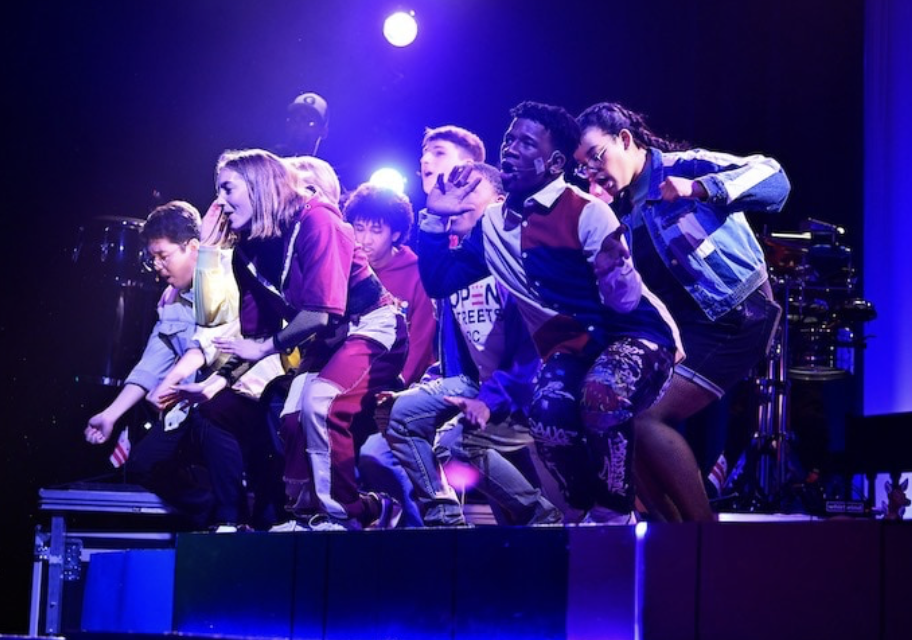★★★★★
Fashion, community, life: what do these three words have in common? Each comes together to compose the soundtrack of Washington, D.C., go-go music.
With a vibrant funk-style sound and an energetic rhythm, go-go music encapsulates the soul of the District and its ever-changing culture. Although the music was born from the talents of Washington’s Black musicians in the 1960s and 1970s — largely from the Godfather of go-go, Chuck Brown — the genre’s unmistakable beat continues to enliven the streets of D.C. today, making its way to Georgetown’s campus. Each song tells a story of struggle and passion, of connection and resilience, a message that echoed across the stage of Gonda Theater during Georgetown’s student performance “Making the Go-Go Band.”
Mixing the elements of a musical, cultural and historical showcase, the performance featured both students and local go-go musicians. Performers danced and sang on a vivid, intricate map of D.C. painted atop the stage. The unique set design, coupled with the constant live go-go music throughout the performance, highlighted the energetic nature of the genre. Alternating between segments of singing and rhythmically speaking to go-go music, the performers presented a thorough account of go-go’s significance.
“Making the Go-Go Band” diverged from traditional musicals and theatrical performances and fostered a personal bond with the audience. The show opened with a traditional call and repeat-style song in which each cast member sang their name and the place they call home to introduce themselves. As the audience repeated each introduction, the performers and audience built a personalized, intimate relationship central to the show’s authenticity.
The show touched on go-go’s history and its role in D.C., with references to well-known places like the Kennedy Center and Embassy Row, but it also delved into the history of lesser-known places — for example, the impact of go-go on New Balance sneakers at the shoe store Prince & Princess, a staple of the Georgetown neighborhood.
The social and cultural relevance of go-go, in D.C. but especially in Georgetown, reached its peak in the show when the performers staged a protest against the erasure of go-go. While educating the audience about the effects of gentrification and government action on the decline of go-go’s presence, the cast members held signs reading messages like “don’t mute DC.” Their compelling message spread far beyond the stage, instilling in each audience member a desire to take action for this urgent social cause.
Still, the show remained light-hearted and energetic, featuring a 10-minute dance party in the second act. Unexpected and original, this segment allowed each audience member to feel the power of go-go — from their feet moving in synchronization with the beat, to the surrounding crowd grooving with them, the music spoke to go-go’s ability to enliven the diverse residents of D.C. and beyond.
With engaging segments like go-go trivia, the show struck an ideal balance between entertainment and education. The live band highlighted the adaptability of go-go music, even improvising a go-go rendition of an audience-selected song. Moreover, in a special segment with a-tune, a band made up of students from Osaka University in Japan, the audience learned of their invented instrument, the peritone. While the Japanese band demonstrated how to play this instrument, the live band created a go-go-style accompaniment on the spot, showing the impressive global impact of go-go.
The show sustained its audience enthusiasm during its entire two hour and 30 minute runtime. Audience members were constantly bopping to the irresistible beat of the music, and the shows’ leaders, Charles “Shorty Corleone” Garris and Natsu Onoda Power, encouraged their enthusiasm by converting the orchestra pit into a dancing section. Between the call and repeat style songs and the audience’s constant dancing in front of the stage, the performers facilitated a memorable atmosphere that truly encapsulated the spirit of go-go.
The show closed with a segment spotlighting personal anecdotes from each of the band members about go-go’s role in their lives. From heartfelt childhood stories about growing up in D.C. to reflections on the profound impact of go-go, each narrative captured the heart of go-go in a personal way. Audience members gained an understanding of the larger-than-life sound of go-go, a sound that echoes beyond the borders of D.C., reverberating in the souls of individuals across the world. Throughout the phenomenal showcase of go-go music, one recurring line of the call and repeat songs rang clear: “go-go is not just music, it is fashion, it is community, it is life.”














